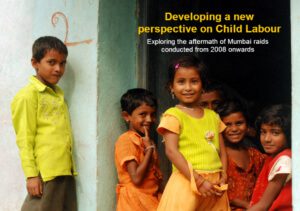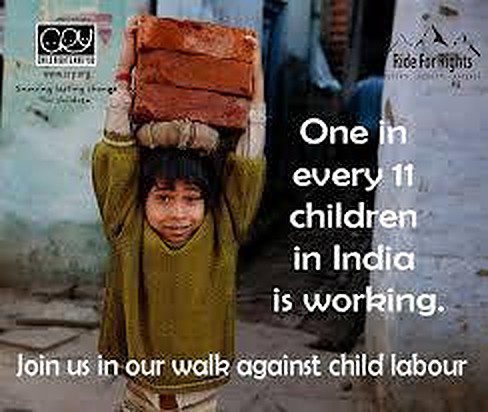On the occasion of World Day Against Child Labour CRY organised an e-consultation to underscore how the COVID-19 pandemic will affect the situation of the child and adolescent labour in India. A report for Different Truths.
The unprecedented humanitarian crisis caused by the COVID-19 pandemic has already had a huge impact on the Indian economy, and there are high chances that child labour in home-based enterprises, agriculture and hazardous occupations may see a steep rise in the coming months, stated a media release.
With a huge impact caused by the COVID-19 pandemic on the already struggling Indian economy, financial insecurity in poor households increased due to massive loss of work and wages and reduced employment opportunities, thus making children more vulnerable. They are likely to be pushed into unskilled labour to compensate for the economic loss …. In all likelihood, these children may choose to work instead of study to help their families in future.
With a huge impact caused by the COVID-19 pandemic on the already struggling  Indian economy, financial insecurity in poor households increased due to massive loss of work and wages and reduced employment opportunities, thus making children more vulnerable. They are likely to be pushed into unskilled labour to compensate for the economic loss and to supplement dwindling family income, especially the older children, who are experiencing the struggle of their families and loss of livelihood. In all likelihood, these children may choose to work instead of study to help their families in future.
Indian economy, financial insecurity in poor households increased due to massive loss of work and wages and reduced employment opportunities, thus making children more vulnerable. They are likely to be pushed into unskilled labour to compensate for the economic loss and to supplement dwindling family income, especially the older children, who are experiencing the struggle of their families and loss of livelihood. In all likelihood, these children may choose to work instead of study to help their families in future.
In this context CRY – Child Rights and You organised an e-consultation to underscore how the COVID-19 pandemic will affect the situation of the child and adolescent labour in India. As the two-hour-long session unpacked multiple reasons of the imminent increase of child labour in agriculture and family enterprises, it also highlighted how the recent labour law relaxations in some states will have its far-reaching effects on adolescent labour while exploring the collective effort of civil society and state can combat child labour, it was informed.
As the two-hour-long session unpacked multiple reasons of the imminent increase of child labour in agriculture and family enterprises, it also highlighted how the recent labour law relaxations in some states will have its far-reaching effects on adolescent labour while exploring the collective effort of civil society and state can combat child labour.
The media release added that the experts’ panel was chaired by Priyank Kanoongo, Chairperson, NCPCR (National Commission for Protection of Child Rights) and included Rahul Sapkal, Asst. Professor, Centre for Labour Studies, Tata Institute of Social Sciences (TISS); Protiva Kundu, Additional Coordinator – Research, Centre for Budget and Governance Accountability (CBGA) and Ashok Kumar, Convener of National Advocacy at CACL (Campaign against Child Labour). The panel discussion was moderated by Puja Marwaha, CEO at CRY.
Priyank Kanoongo, Chairperson of NCPCR, who chaired the panel highlighted that it is crucial to use existing laws efficiently to address child labour. “We need to ensure that we are using the existing laws, not sitting and feeling helpless. Number of FIRs filed so far is extremely poor compared to a large number of child labour in the country. Therefore, it is everyone’s responsibility to report and file FIRs on child labour. I also appeal to civil society organisations to help strengthen reporting mechanisms and compensation/rehabilitation schemes to address child labour in the country,” said Priyank Kanoongo.
Priyank Kanoongo, Chairperson of NCPCR, who chaired the panel highlighted that it is crucial to use existing laws efficiently to address child labour. “We need to ensure that we are using the existing laws, not sitting and feeling helpless. Number of FIRs filed so far is extremely poor compared to a large number of child labour in the country. Therefore, it is everyone’s responsibility to report and file FIRs on child labour…”
Puja Marwaha, CEO at CRY said, “I truly resonate and believe that only the time all Indians start believing that children below 18 years don’t have to work because they are poor or for any other reason, it is that day we will start changing the situation. The advent of COVID-19 seems to be one major contributing factor to undo all efforts made in reducing and ending child labour. Though Child protection programming is vital to resolve the issue, CRY believes that the mechanism will be effective only when there is convergence amongst key departments of Women and Child Development, Education, Labour, Health and Home Affairs.”
Rahul Sapkal, Asst. Professor, Centre for Labour Studies, Tata Institute of Social Sciences (TISS) said, “The changes in labour laws will weaken enforcement mechanism which may further increase child labour amid this crisis. The Child Labour legislation needs to be revised as many aspects of climate change and hazardous industries are not yet incorporated. This revision must include revisiting the definition of what constitutes as hazardous industries keeping the developing capacities of children in mind.”
Protiva Kundu, Additional Coordinator- Research, Centre for Budget and Governance Accountability (CBGA) said, “COVID-19 crisis will lead to a surge in child labour. The government should expand the coverage of NCLP scheme in all districts which is currently operating in 323 districts and spend on a survey of identifying child labour…”
Protiva Kundu, Additional Coordinator- Research, Centre for Budget and  Governance Accountability (CBGA) said, “COVID-19 crisis will lead to a surge in child labour. The government should expand the coverage of NCLP scheme in all districts which is currently operating in 323 districts and spend on a survey of identifying child labour. Also, it is high time to address dropouts in schools and government should expand RTE act up to class 12.”
Governance Accountability (CBGA) said, “COVID-19 crisis will lead to a surge in child labour. The government should expand the coverage of NCLP scheme in all districts which is currently operating in 323 districts and spend on a survey of identifying child labour. Also, it is high time to address dropouts in schools and government should expand RTE act up to class 12.”
Meanwhile, Ashok Kumar, Convener of National Advocacy at CACL (Campaign against Child Labour) added, “For the next 5 years, there is vital need to only invest in children. The focus should be on a full-fledged rehabilitation package to address child labour and extend RTE to a higher secondary level so that child labour will be abolished.”
Meanwhile, Ashok Kumar, Convener of National Advocacy at CACL (Campaign against Child Labour) added, “For the next 5 years, there is vital need to only invest in children. The focus should be on a full-fledged rehabilitation package to address child labour and extend RTE to a higher secondary level so that child labour will be abolished.”
CRY recommendations to ensure that children are not engaged in work:
- The Union and State Governments need to make concerted efforts to improve the public health system along with strengthening social security, education and child protection mechanisms.
- Children from marginalised communities are at a high risk of dropping out of education, and the community level child protection mechanisms including the village child protection committees, along with Panchayati Raj Institutions, School Management Committees must track every child in their villages and ensure their safety, especially from trafficking, underage marriage and forced labour.
- Stringent enforcement of the child labour law, the Integrated Child Protection Services Scheme is critical to safeguard children from the impact of the COVID-19, including the fallouts of the economic slowdown. The government should also open special training centres with bridge classes in keeping with social distancing and other norms to help children make up for the academic loss.
- Ensuring the continuation of education for all children, especially the ones from marginalised households would be critical at this juncture. While efforts have been made to continue education for children through remote teaching options such as online classes, radio, television etc., most children from poor families do not have access to these media. Adequate investments must be made so that these families are given incentives to access these media for remote learning.
- Non-Government and Civil Society Organisations should support and strengthen government efforts, especially when it comes to identifying vulnerable children. They also join in the effort to build awareness and act as channels for multiplying children’s voices. They can also play a huge role in reaching out to last-mile child and families and help the government to deliver the social protection schemes to children and their families.
Background Notes
- Children’s demand in manual work in the agriculture sector, home-based enterprises and small scale business might increase rapidly in the coming days.
- Recently, due to COVID-19, several states (including those with a high prevalence of child and adolescent labour) have made relaxations to their labour laws including extending work hours from 8 hours to 12 hours per day, limited time for rest, relaxations in inspections and monitoring by authorities, restricted grievance redress mechanisms and collective bargaining through labour unions.
- Even though labour laws for children remain unchanged, the spill-over effect of adult workers is likely to have a negative impact, especially for adolescent workers. Children are always considered as ‘cheap labour’ hence vastly preferred and employed by the labour market and employers. In the absence of availability of adult labourers in urban areas (since they have migrated to their native places), the demand for employing children especially adolescents may rise in the coming days. Possibilities are, many of them will be forced to work for long hours, in hazardous and often abusive environments, for little or no pay, and often far from home.
- The closure of schools exacerbates the risk of an increase in working children since drop-out children will either be directly supporting their families or caught in trafficking, begging, debt bondage and other indecent and exploitative work conditions.
- According to Census 2011 data, the total number of child labourers in India between 5-14 years is 4.35 million (main workers) and 5.76 million (marginal workers), which comes to a total of 10.11 million.
- Furthermore, the total number of adolescent labourers in India is 22.87 million, bringing the total (5-18 years) to around 33 million. 62% of child labourers between the age-group of 5-14 years are concentrated in agriculture, forestry and fishing, closely followed by industries and services. Children are also involved in ‘worst forms of child labour’ including forced labour, bonded labour, children being used, procured or offered for prostitution, pornography and trafficking of drugs.
Children are also involved in ‘worst forms of child labour’ including forced labour, bonded labour, children being used, procured or offered for prostitution, pornography and trafficking of drugs.
Photos from the Internet





 By
By

 By
By
 By
By